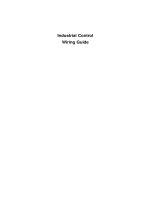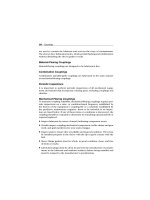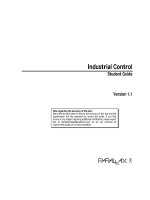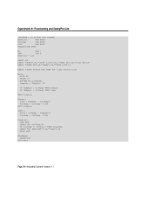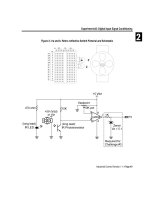Industrial Control Wiring Guide 2 2010 Part 1 pptx
Bạn đang xem bản rút gọn của tài liệu. Xem và tải ngay bản đầy đủ của tài liệu tại đây (53.7 KB, 9 trang )
Industrial Control
Wiring Guide
Industrial Control
Wiring Guide
Second edition
Bob Mercer
OXFORD AUCKLAND BOSTON JOHANNESBURG MELBOURNE NEW DELHI
Newnes
An imprint of Butterworth-Heinemann
Linacre House, Jordan Hill, Oxford OX2 8DP
225 Wildwood Avenue, Woburn, MA 01801-2041
A division of Reed Educational and Professional Publishing Ltd.
A member of the Reed Elsevier plc group
First published 1995
Reprinted 1996, 1998, 1999
Second edition 2001
© R. B. Mercer 1995, 2001
All rights reserved. No part of this publication may be reproduced in
any material form (including photocopying or storing in any medium by
electronic means and whether or not transiently or incidentally to some
other use of this publication) without the written permission of the
copyright holder except in accordance with the provisions of the Copyright,
Designs and Patents Act 1988 or under the terms of a licence issued by the
Copyright Licensing Agency Ltd, 90 Tottenham Court Road, London,
England W1P 0LP. Applications for the copyright holder’s written
permission to reproduce any part of this publication should be addressed
to the publishers
British Library Cataloguing in Publication Data
A catalogue record for this book is available from the British Library
ISBN 0 7506 3140 6
Composition by Genesis Typesetting, Laser Quay, Rochester, Kent
Printed and bound in Great Britain
1 Safety 1
1.1. Personal safety 1
1.2. Building safe equipment 4
2 Drawings 7
2.1. Types of drawing 7
2.2. Symbols 9
3 Wire types and preparation 17
3.1. Insulation materials 17
3.2. Conductors 18
3.3. Wire specifications 18
3.4. Standard Wire Gauge 19
3.5. Coaxial and screened wire 19
3.6. Multiway cables 20
3.7. Insulation removal 21
4 Soldering and termination 26
4.1. Soldering equipment 26
4.2. Solder 28
4.3. Forming the wire 29
4.4. Soldering the joint 30
4.5. Crimped joints 34
4.6. Screw clamp terminals 40
4.7. Terminating coaxial cable 41
5 Cable forming 47
5.1. Cableforms 47
5.2. Continuous lacing 49
5.3. Breakouts 52
5.4. Spot ties 56
5.5. Laying the wires 56
5.6. Twisted pairs 58
5.7. Cable markers 60
6 Connections and routing 62
6.1. General 62
6.2. Conductor and cable runs 66
6.3. Conductors of different circuits 67
7 Hardware 68
7.1. Component mounting rails 68
7.2. Plastic trunking 69
7.3. Connector blocks 72
7.4. Screw terminals 75
8 Components (active) 76
8.1. Contactors and relays 76
8.2. Contactors 83
8.3. Transformers 88
9 Components (passive) 92
9.1. Fuses 92
9.2. Resistors 96
9.3. Capacitors 103
10 Switches and lamps 108
10.1. Switches 108
10.2. Lamps 112
11 Earthing and screening 114
11.1. Earthing the protective bonding
circuit 114
11.2. Screen connections 120
11.3. System earth terminals 120
12 PLC wiring 122
12.1. Installation 122
12.2. Power supply wiring 123
12.3. Earthing 123
12.4. Wiring of inputs and outputs 124
1. SAFETY
1.1.2. Fire
Before commencing work on electric plant, you
should know:
᭹ Where is the nearest fire alarm activator, fire exit
and fire extinguisher?
᭹ Are the fire exits clear of equipment or
rubbish?
1.1.3. Extinguishers for electrical fires
Be aware that special extinguishers are needed for
fires which occur in live electrical equipment – do not
use water-based extinguishers.
᭹ RED extinguishers are water-based for wood/
paper/cloth/plastic fires only.
᭹ GREEN extinguishers are halon or BCF-based
for general fires (not gases) including electrical
fires.
᭹ BLACK extinguishers are CO
2
-based for flam-
mable liquids and electrical fires.
1.1.4. Electric shock
Learn the basic first aid action drill.
᭹ DO NOT TOUCH the victim with your bare
hands until the power is off or they have been
pulled away from contact otherwise you will get
a shock as well.
᭹ Switch off the power and drag the victim off the
live conductor.
᭹ Alternatively if you cannot switch off then use
something non-conducting to move the victim
away from contact. Dry wood, plastic tubing
(PVC conduit) even a dry piece of cloth folded
several times will do.
2
1. SAFETY
1.1.5. Working with electrical equipment
Many of the tools we use are electrically powered,
some by the mains, some by battery.
᭹ Mains-driven portable tools should be connected
to the supply through an isolating transformer.
᭹ These are usually 110 V systems which reduce
the effect of electric shock.
᭹ Heavier, fixed machines are wired into the three-
phase factory supply. This is 415 V and there are
stringent safety regulations governing its installa-
tion and use.
Remember . . .
᭹ Do not take liberties or chances with electricity.
᭹ Don’t interfere with electrical apparatus, i.e. use it as intended and don’t remove any covers or
panels.
᭹ Don’t use or tamper with electrical machinery and tools that do not concern you. Leave switches and
buttons alone. If you want to know how something works then ask someone who is authorised to
show you.
᭹ Take care when using portable electric power tools since these cause the highest number of accidents
in the workplace. Accident possibilities range from tripping over a carelessly laid power cord to
getting swarf in your eye because you didn’t wear eye protection.
3


